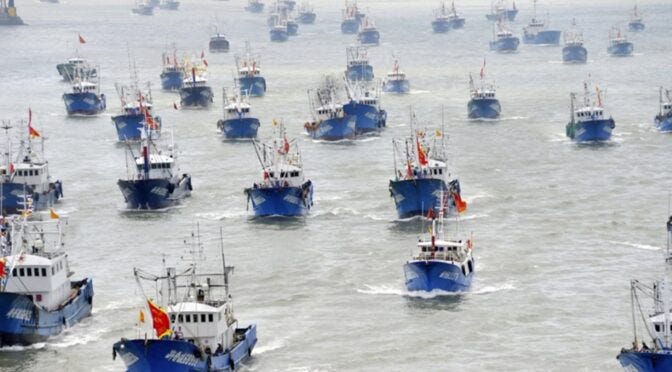The term “Little Blue Men” was coined by Dr. Andrew S. Erickson, a professor at the US Naval War College, and has gained mainstream use in reference to China’s People’s Armed Forces Maritime Militia (PAFMM). It is an irregular maritime force, made up of fishing boats, that China uses in the South China Sea (SCS) to enforce its territorial claims. China has denied such assertions. China claims nearly 90% of the SCS under the controversial Nine-Dash Line; it says that according to history, these waters have always been Chinese. This claim is very contested and is unlikely to be historically accurate. In 2016, the Permanent Court of Arbitration ruled that China had no such rights with respect to arbitration with the Philippines and that China could only claim what is designated under the United Nations Convention on the Law of the Sea, of which China is a party to.

China’s maritime militias apparently came into being first as a coastal patrol and surveillance force, between the 1950s and 1970s. Then, they were directed toward asserting China’s contested sovereignty. The use of maritime militias is not a recent phenomenon; in 1974, some Chinese fishing vessels were involved in the Battle of the Paracel Islands, with Vietnam. The vessels started circling the islands the year before and transferring Chinese assets to them. As per Vietnamese sources, the crews of these vessels were armed. Since then, China has increasingly been relying on the Little Blue Men to enforce its claims and assert its sovereignty. According to the Center for Strategic and International Studies (CSIS), Chinese fishing militias became more aggressive in the 2000s, and even more so since the early 2010s, when Xi Jinping took over. They sometimes are accompanied or aided by the People’s Liberation Army Navy (PLAN) and Chinese coast guard vessels on operations. The Chinese government subsidizes some vessels’ construction and has support programs (financial and otherwise) for them.
Some examples of incidents involving the Little Blue Men, from CSIS:
A Chinese fishing vessel damaged the USNS Bowditch’s towed sensor array in the Yellow Sea in 2002. The vessel is a US Navy survey ship.
The USNS Impeccable was met by PLAN, the Chinese coast guard, and Little Blue Men, south of Hainan, in 2009. One fishing vessel tried to damage the sonar array the Impeccable was towing, with militia members also attempting to hook on to the array.
Chinese fishing vessels harassed and attempted to disrupt operations of a vessel surveying an oil and gas block in 2011. The vessel was contracted by the Vietnamese national oil and gas company and Japan’s second-largest petroleum refiner to operate 150 nautical miles from Vietnam’s coast.
President Xi Jinping called the Tanmen Militia “a model for others to follow”. The Tanmen Maritime Militia Company is one of China’s leading militias. It was involved in the 2012 Scarborough Shoal Standoff, between China and the Philippines in the SCS. China effectively wrested control over the disputed area from the Philippines and has since militarized it.
China and Vietnam were engaged in a standoff over a Chinese rig conducting exploratory drilling in disputed waters in the SCS in 2014. Vessels on both sides engaged in ramming and used water hoses. One Vietnamese fishing boat was sunk.
A Chinese coast guard vessel rammed into a Chinese fishing vessel that had been captured by Indonesia, to free it, in the Natuna Sea in 2016. Indonesian authorities had arrested the vessel for illegally fishing in its waters.
A Chinese fishing vessel rammed into a Filipino fishing vessel, at night, while it was anchored, at the Reed Bank in 2019. The bank is within the Philippines Exclusive Economic Zone in the SCS. The vessel was sunk, and the Filipino fishermen narrowly escaped death; they were rescued by a Vietnamese vessel in the area. The Chinese vessel fled the scene after ramming the Filipino boat.
Chinese fishing vessels directed lasers toward an Australian navy helicopter during a regional mission in the SCS in 2019. The helicopter was forced to land.

Some of China’s fishing vessels are very unlike those used in the SCS. They are steel-hulled (apparently reinforced) and have high-pressure water cannons and collision-absorbing rails. They have range and can travel large distances (China’s outposts in the SCS support their operations). Some are said to hold arms and ammunition. They are also fast; according to a former director of operations at the US Pacific Command’s Joint Intelligence Center. The same official said that the Chinese fishing vessels “don’t fish”. Sometimes, crew members are military veterans or demobilized troops; some fishermen have also gone through military training. Some vessels report directly to provincial military districts.
China’s maritime militias conduct an array of operations, aside from fishing. They harass foreign vessels, whether they be Southeast Asian, or Western. They swarm, with overwhelming numbers, areas, to prevent other ships from accessing an area. They provide logistics and operational support in disputed areas of the SCS. They are used for surveillance and support operations. They obstruct vessels. They have been key assets in China’s militarization of the SCS. They operate in a “Grey Zone”. They can act in ways that the PLAN cannot (officially at least), and thus hinder countries’ ability to respond to them. If Chinese fishing vessels are embroiled in a conflict, that also gives an excuse for the PLAN or the Chinese coast guard to be deployed, to protect Chinese interests.
The Little Blue Men are the vanguard of China’s attempts to enforce its sovereignty in disputed waters, especially in the SCS. Over the decades, they have become more brazen, and integral to China’s foreign policy. With China’s assertions over its territorial claims increasing, the Little Blue Men will continue to play a key role.




